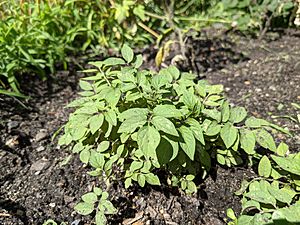Solanum caripense facts for kids
Quick facts for kids Solanum caripense |
|
|---|---|
 |
|
| A young Solanum caripense plant growing. | |
| Scientific classification | |
| Genus: |
Solanum
|
| Species: |
caripense
|
Solanum caripense is a type of evergreen shrub that grows naturally in South America. It is grown for its tasty fruit.
This plant is not very common to find in gardens, and it's known as tzimbalo. Its fruit looks a lot like the pepino (Solanum muricatum), which is a related plant. Some people think that tzimbalo might be the wild plant that the pepino came from! Like the pepino, the tzimbalo is part of the nightshade family. This family also includes other plants grown for their edible fruits, such as the tomato (S. lycopersicum), the naranjilla (S. quitoense), and the eggplant (S. melongena).
The tzimbalo fruit is not often grown in its home countries of Colombia, Ecuador, Bolivia, Peru, and Chile. However, some special gardeners around the world have started growing it again on a small scale.
About the Tzimbalo Plant
The tzimbalo plant is thought to come from the cool Andean mountains in Colombia, Ecuador, Peru, and Chile. Like the pepino, tzimbalo plants can start growing fruit within one or two years after you plant their seeds.
The fruits are round berries, about 2 centimeters (less than an inch) big. They turn yellow or light green when they are ripe. They also have dark stripes running along them. The taste and feel of the tzimbalo fruit are similar to the pepino. However, tzimbalo fruits are usually more tangy and have more juice.
Growing Tzimbalo
The tzimbalo plant grows best in places that are warm and do not get much frost. The plant can survive if the temperature drops to about -2.5 degrees Celsius (27 to 28 degrees Fahrenheit) for a very short time. But it might lose many of its leaves if it gets too cold.
Like its close relatives, the tzimbalo is a perennial plant. This means it can live for many years. However, it doesn't like cold weather, and it can get sick easily. It also needs a long time to grow its fruit. These things make it hard to grow tzimbalo on a very large scale for selling. But tzimbalo plants grow very well inside greenhouses.
Like most plants in the nightshade family that have edible parts, tzimbalo plants can attract pests. These include small bugs like aphids, white flies, beetles, and spider mites.


